Mental Health Case Study: Analyzing Ana's Bipolar Disorder
VerifiedAdded on 2022/09/08
|9
|2351
|12
Case Study
AI Summary
This case study focuses on Ana, a 25-year-old female, and her struggles with mood fluctuations and anxiety, leading to a diagnosis of bipolar disorder likely triggered by a head injury sustained in her youth. The analysis delves into the justifications for this diagnosis, highlighting symptoms such as mania, irritability, impulsive behavior, and feelings of loneliness. It emphasizes the importance of a strong support system, including educating the individual about the illness, providing consistent emotional support, and active participation in treatment processes like therapy and medication adherence. The study also explores alternative treatments such as medication, psychotherapy (including behavioral, social rhythm, and cognitive behavioral therapies), and electroconvulsive therapy, alongside lifestyle changes to manage symptoms. The recommendation is for Ana to seek assistance from a psychiatrist for appropriate treatment and management of her condition. The case study underscores the need for understanding, patience, and consistent support from family and friends to help individuals with bipolar disorder navigate their challenges and improve their quality of life. Desklib provides solved assignments and past papers for students.
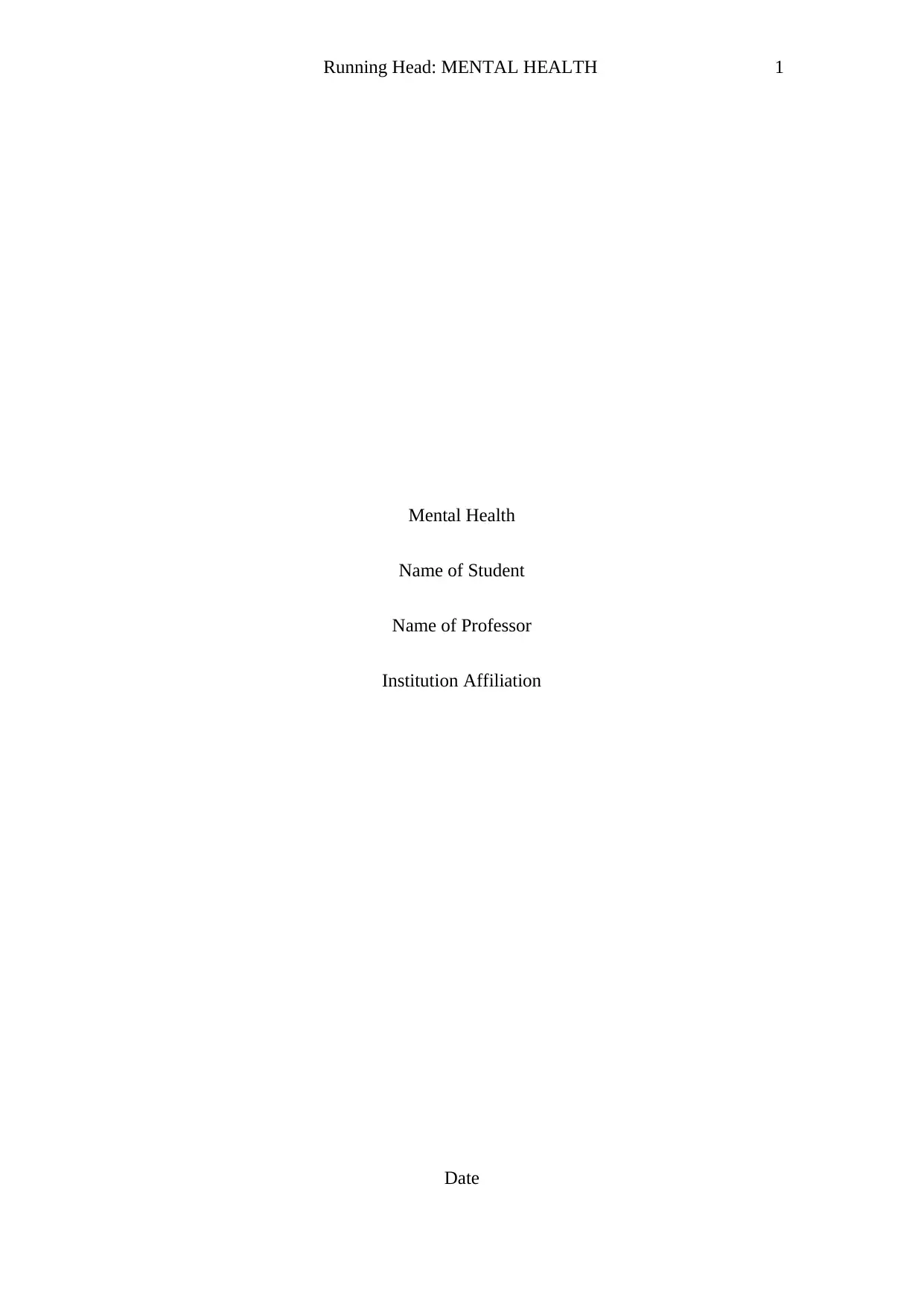
Running Head: MENTAL HEALTH 1
Mental Health
Name of Student
Name of Professor
Institution Affiliation
Date
Mental Health
Name of Student
Name of Professor
Institution Affiliation
Date
Paraphrase This Document
Need a fresh take? Get an instant paraphrase of this document with our AI Paraphraser
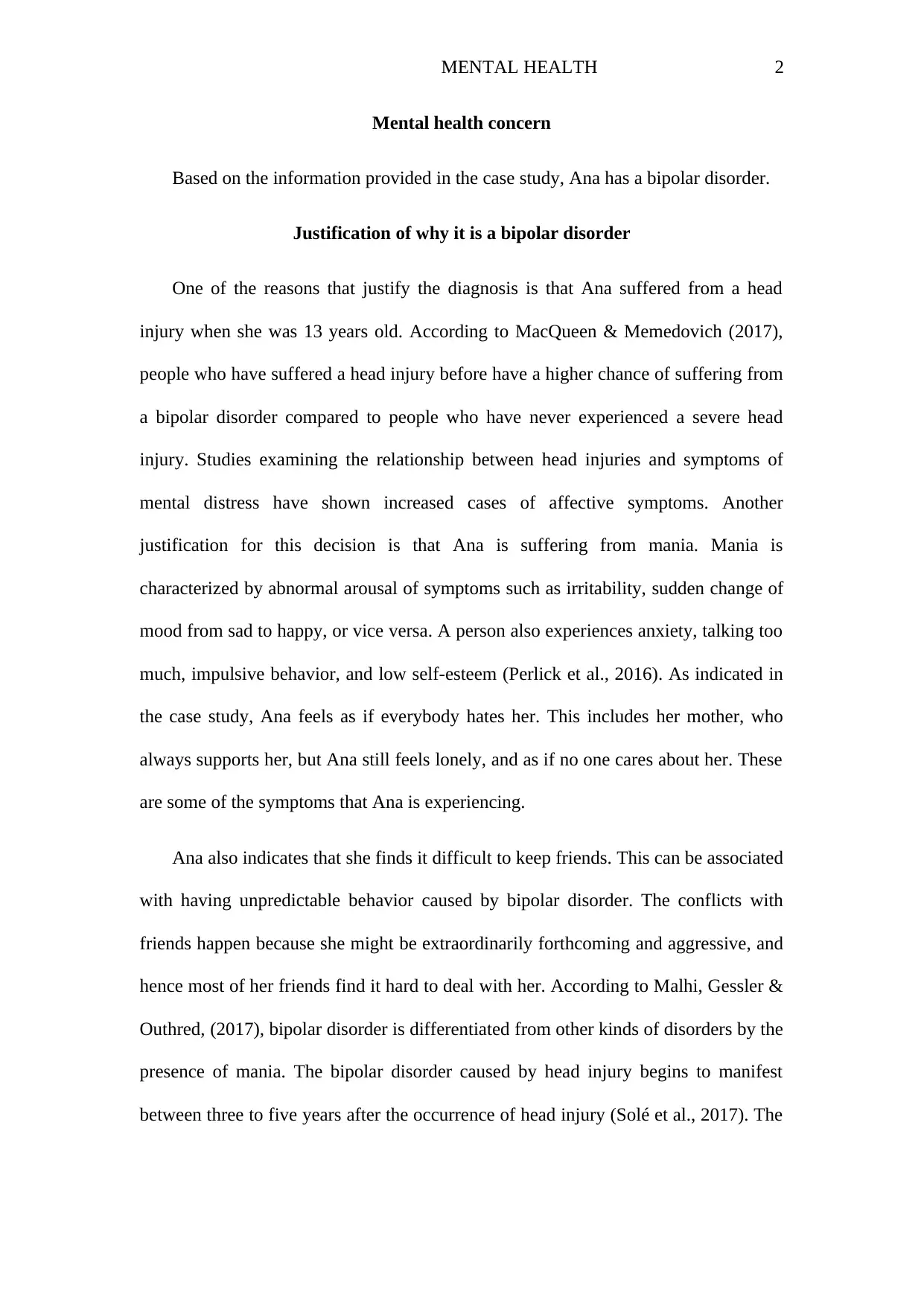
MENTAL HEALTH 2
Mental health concern
Based on the information provided in the case study, Ana has a bipolar disorder.
Justification of why it is a bipolar disorder
One of the reasons that justify the diagnosis is that Ana suffered from a head
injury when she was 13 years old. According to MacQueen & Memedovich (2017),
people who have suffered a head injury before have a higher chance of suffering from
a bipolar disorder compared to people who have never experienced a severe head
injury. Studies examining the relationship between head injuries and symptoms of
mental distress have shown increased cases of affective symptoms. Another
justification for this decision is that Ana is suffering from mania. Mania is
characterized by abnormal arousal of symptoms such as irritability, sudden change of
mood from sad to happy, or vice versa. A person also experiences anxiety, talking too
much, impulsive behavior, and low self-esteem (Perlick et al., 2016). As indicated in
the case study, Ana feels as if everybody hates her. This includes her mother, who
always supports her, but Ana still feels lonely, and as if no one cares about her. These
are some of the symptoms that Ana is experiencing.
Ana also indicates that she finds it difficult to keep friends. This can be associated
with having unpredictable behavior caused by bipolar disorder. The conflicts with
friends happen because she might be extraordinarily forthcoming and aggressive, and
hence most of her friends find it hard to deal with her. According to Malhi, Gessler &
Outhred, (2017), bipolar disorder is differentiated from other kinds of disorders by the
presence of mania. The bipolar disorder caused by head injury begins to manifest
between three to five years after the occurrence of head injury (Solé et al., 2017). The
Mental health concern
Based on the information provided in the case study, Ana has a bipolar disorder.
Justification of why it is a bipolar disorder
One of the reasons that justify the diagnosis is that Ana suffered from a head
injury when she was 13 years old. According to MacQueen & Memedovich (2017),
people who have suffered a head injury before have a higher chance of suffering from
a bipolar disorder compared to people who have never experienced a severe head
injury. Studies examining the relationship between head injuries and symptoms of
mental distress have shown increased cases of affective symptoms. Another
justification for this decision is that Ana is suffering from mania. Mania is
characterized by abnormal arousal of symptoms such as irritability, sudden change of
mood from sad to happy, or vice versa. A person also experiences anxiety, talking too
much, impulsive behavior, and low self-esteem (Perlick et al., 2016). As indicated in
the case study, Ana feels as if everybody hates her. This includes her mother, who
always supports her, but Ana still feels lonely, and as if no one cares about her. These
are some of the symptoms that Ana is experiencing.
Ana also indicates that she finds it difficult to keep friends. This can be associated
with having unpredictable behavior caused by bipolar disorder. The conflicts with
friends happen because she might be extraordinarily forthcoming and aggressive, and
hence most of her friends find it hard to deal with her. According to Malhi, Gessler &
Outhred, (2017), bipolar disorder is differentiated from other kinds of disorders by the
presence of mania. The bipolar disorder caused by head injury begins to manifest
between three to five years after the occurrence of head injury (Solé et al., 2017). The
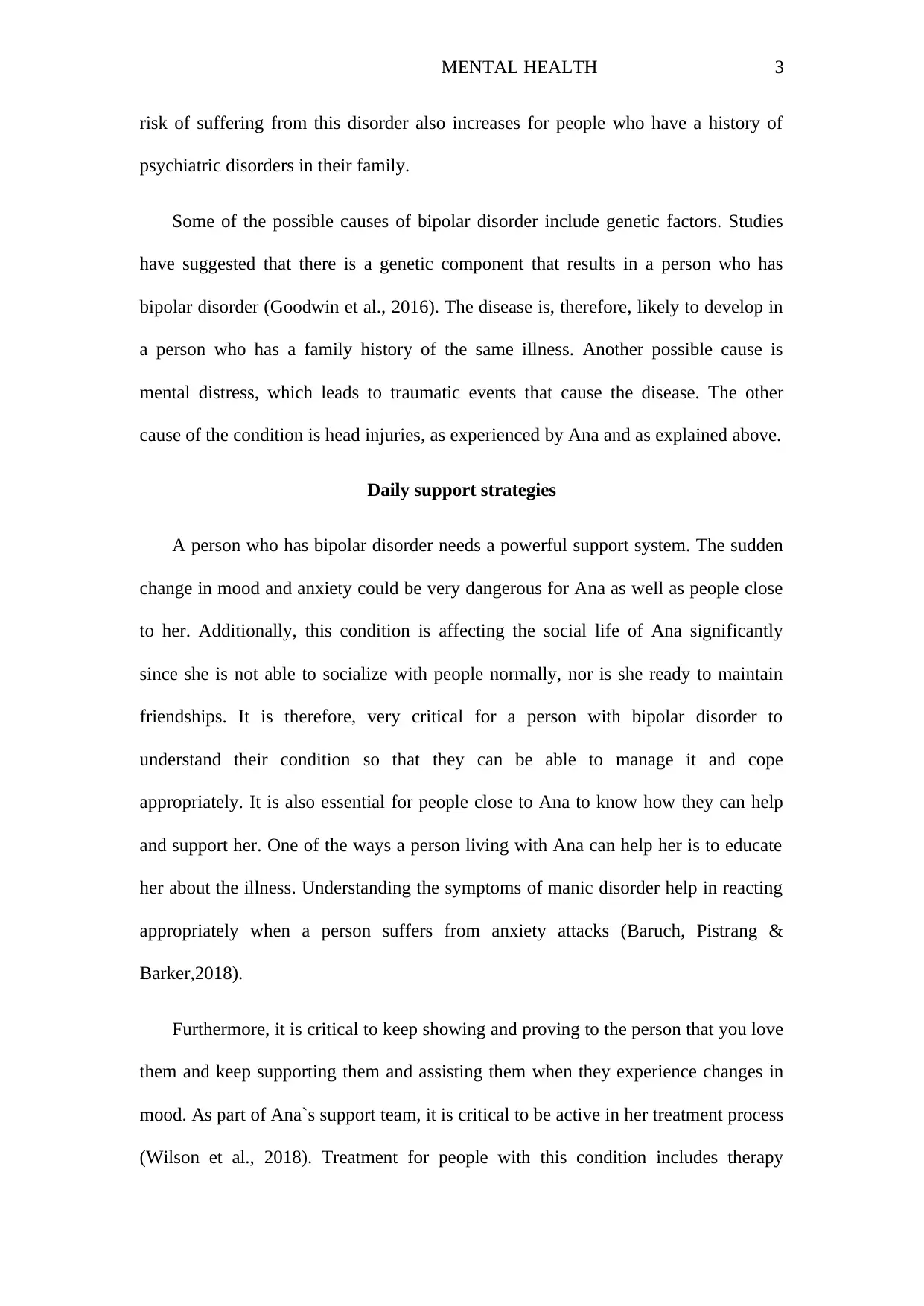
MENTAL HEALTH 3
risk of suffering from this disorder also increases for people who have a history of
psychiatric disorders in their family.
Some of the possible causes of bipolar disorder include genetic factors. Studies
have suggested that there is a genetic component that results in a person who has
bipolar disorder (Goodwin et al., 2016). The disease is, therefore, likely to develop in
a person who has a family history of the same illness. Another possible cause is
mental distress, which leads to traumatic events that cause the disease. The other
cause of the condition is head injuries, as experienced by Ana and as explained above.
Daily support strategies
A person who has bipolar disorder needs a powerful support system. The sudden
change in mood and anxiety could be very dangerous for Ana as well as people close
to her. Additionally, this condition is affecting the social life of Ana significantly
since she is not able to socialize with people normally, nor is she ready to maintain
friendships. It is therefore, very critical for a person with bipolar disorder to
understand their condition so that they can be able to manage it and cope
appropriately. It is also essential for people close to Ana to know how they can help
and support her. One of the ways a person living with Ana can help her is to educate
her about the illness. Understanding the symptoms of manic disorder help in reacting
appropriately when a person suffers from anxiety attacks (Baruch, Pistrang &
Barker,2018).
Furthermore, it is critical to keep showing and proving to the person that you love
them and keep supporting them and assisting them when they experience changes in
mood. As part of Ana`s support team, it is critical to be active in her treatment process
(Wilson et al., 2018). Treatment for people with this condition includes therapy
risk of suffering from this disorder also increases for people who have a history of
psychiatric disorders in their family.
Some of the possible causes of bipolar disorder include genetic factors. Studies
have suggested that there is a genetic component that results in a person who has
bipolar disorder (Goodwin et al., 2016). The disease is, therefore, likely to develop in
a person who has a family history of the same illness. Another possible cause is
mental distress, which leads to traumatic events that cause the disease. The other
cause of the condition is head injuries, as experienced by Ana and as explained above.
Daily support strategies
A person who has bipolar disorder needs a powerful support system. The sudden
change in mood and anxiety could be very dangerous for Ana as well as people close
to her. Additionally, this condition is affecting the social life of Ana significantly
since she is not able to socialize with people normally, nor is she ready to maintain
friendships. It is therefore, very critical for a person with bipolar disorder to
understand their condition so that they can be able to manage it and cope
appropriately. It is also essential for people close to Ana to know how they can help
and support her. One of the ways a person living with Ana can help her is to educate
her about the illness. Understanding the symptoms of manic disorder help in reacting
appropriately when a person suffers from anxiety attacks (Baruch, Pistrang &
Barker,2018).
Furthermore, it is critical to keep showing and proving to the person that you love
them and keep supporting them and assisting them when they experience changes in
mood. As part of Ana`s support team, it is critical to be active in her treatment process
(Wilson et al., 2018). Treatment for people with this condition includes therapy
⊘ This is a preview!⊘
Do you want full access?
Subscribe today to unlock all pages.

Trusted by 1+ million students worldwide

MENTAL HEALTH 4
sections and continuously visiting the doctor as well as taking some medication.
Patients suffering from this condition might fear attending therapy sections, and it is,
therefore, essential to be around to assist. Furthermore, some patients suffering from
this kind of disorder might avoid taking medication. As part of the support system, it
is vital to ensure that Ana adheres to the medicines prescribed to her and that she
attends all therapy sections as instructed by the doctor (Dunne, Perich & Meade,
2019). As Ana undergoes bipolar treatment, it is vital to have an emergency plan in
place. This is important since the patient might develop severe mood disorder and
might develop thoughts of committing suicide, especially during depressive episodes.
The plan includes having something which can distract her thoughts, especially using
things that they may find interesting.
According to Boyers & Simpson Rowe, (2018), giving a listening ear to a person
who has bipolar disorder could go a long way in helping them to deal with this
condition. A person suffering from this condition sometimes find themselves in a
situation where they talk too much. It is good to listen to them rather than ignore
them. Listen to Ana can help her since she will feel accepted and respected, and hence
she will be able to deal with the feeling of loneliness (Pacchiarotti et al., 2016).
It is also crucial for one to be understanding when they are dealing with a person
suffering from bipolar disorder. A person like Ana might not comprehend some of her
actions, and hence she might do something terrible and come to realize later. This is
because a person with this condition never realizes that their mood is changing. It is,
therefore, critical to understanding her even when she does something annoying.
Furthermore, many times a person with this condition might not appreciate the efforts
a person is putting into helping her. She might also resist attempts to offer her support
sections and continuously visiting the doctor as well as taking some medication.
Patients suffering from this condition might fear attending therapy sections, and it is,
therefore, essential to be around to assist. Furthermore, some patients suffering from
this kind of disorder might avoid taking medication. As part of the support system, it
is vital to ensure that Ana adheres to the medicines prescribed to her and that she
attends all therapy sections as instructed by the doctor (Dunne, Perich & Meade,
2019). As Ana undergoes bipolar treatment, it is vital to have an emergency plan in
place. This is important since the patient might develop severe mood disorder and
might develop thoughts of committing suicide, especially during depressive episodes.
The plan includes having something which can distract her thoughts, especially using
things that they may find interesting.
According to Boyers & Simpson Rowe, (2018), giving a listening ear to a person
who has bipolar disorder could go a long way in helping them to deal with this
condition. A person suffering from this condition sometimes find themselves in a
situation where they talk too much. It is good to listen to them rather than ignore
them. Listen to Ana can help her since she will feel accepted and respected, and hence
she will be able to deal with the feeling of loneliness (Pacchiarotti et al., 2016).
It is also crucial for one to be understanding when they are dealing with a person
suffering from bipolar disorder. A person like Ana might not comprehend some of her
actions, and hence she might do something terrible and come to realize later. This is
because a person with this condition never realizes that their mood is changing. It is,
therefore, critical to understanding her even when she does something annoying.
Furthermore, many times a person with this condition might not appreciate the efforts
a person is putting into helping her. She might also resist attempts to offer her support
Paraphrase This Document
Need a fresh take? Get an instant paraphrase of this document with our AI Paraphraser
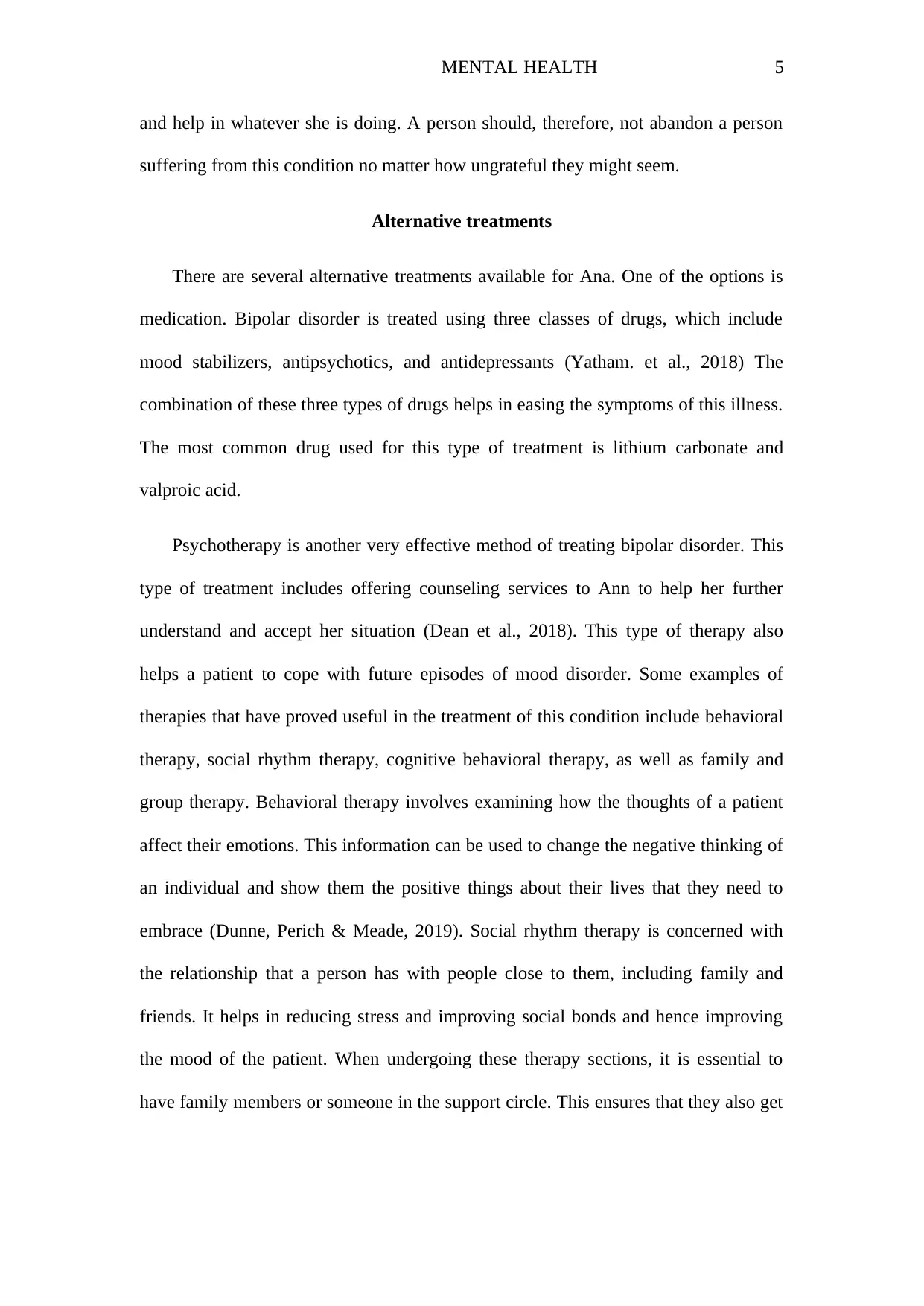
MENTAL HEALTH 5
and help in whatever she is doing. A person should, therefore, not abandon a person
suffering from this condition no matter how ungrateful they might seem.
Alternative treatments
There are several alternative treatments available for Ana. One of the options is
medication. Bipolar disorder is treated using three classes of drugs, which include
mood stabilizers, antipsychotics, and antidepressants (Yatham. et al., 2018) The
combination of these three types of drugs helps in easing the symptoms of this illness.
The most common drug used for this type of treatment is lithium carbonate and
valproic acid.
Psychotherapy is another very effective method of treating bipolar disorder. This
type of treatment includes offering counseling services to Ann to help her further
understand and accept her situation (Dean et al., 2018). This type of therapy also
helps a patient to cope with future episodes of mood disorder. Some examples of
therapies that have proved useful in the treatment of this condition include behavioral
therapy, social rhythm therapy, cognitive behavioral therapy, as well as family and
group therapy. Behavioral therapy involves examining how the thoughts of a patient
affect their emotions. This information can be used to change the negative thinking of
an individual and show them the positive things about their lives that they need to
embrace (Dunne, Perich & Meade, 2019). Social rhythm therapy is concerned with
the relationship that a person has with people close to them, including family and
friends. It helps in reducing stress and improving social bonds and hence improving
the mood of the patient. When undergoing these therapy sections, it is essential to
have family members or someone in the support circle. This ensures that they also get
and help in whatever she is doing. A person should, therefore, not abandon a person
suffering from this condition no matter how ungrateful they might seem.
Alternative treatments
There are several alternative treatments available for Ana. One of the options is
medication. Bipolar disorder is treated using three classes of drugs, which include
mood stabilizers, antipsychotics, and antidepressants (Yatham. et al., 2018) The
combination of these three types of drugs helps in easing the symptoms of this illness.
The most common drug used for this type of treatment is lithium carbonate and
valproic acid.
Psychotherapy is another very effective method of treating bipolar disorder. This
type of treatment includes offering counseling services to Ann to help her further
understand and accept her situation (Dean et al., 2018). This type of therapy also
helps a patient to cope with future episodes of mood disorder. Some examples of
therapies that have proved useful in the treatment of this condition include behavioral
therapy, social rhythm therapy, cognitive behavioral therapy, as well as family and
group therapy. Behavioral therapy involves examining how the thoughts of a patient
affect their emotions. This information can be used to change the negative thinking of
an individual and show them the positive things about their lives that they need to
embrace (Dunne, Perich & Meade, 2019). Social rhythm therapy is concerned with
the relationship that a person has with people close to them, including family and
friends. It helps in reducing stress and improving social bonds and hence improving
the mood of the patient. When undergoing these therapy sections, it is essential to
have family members or someone in the support circle. This ensures that they also get
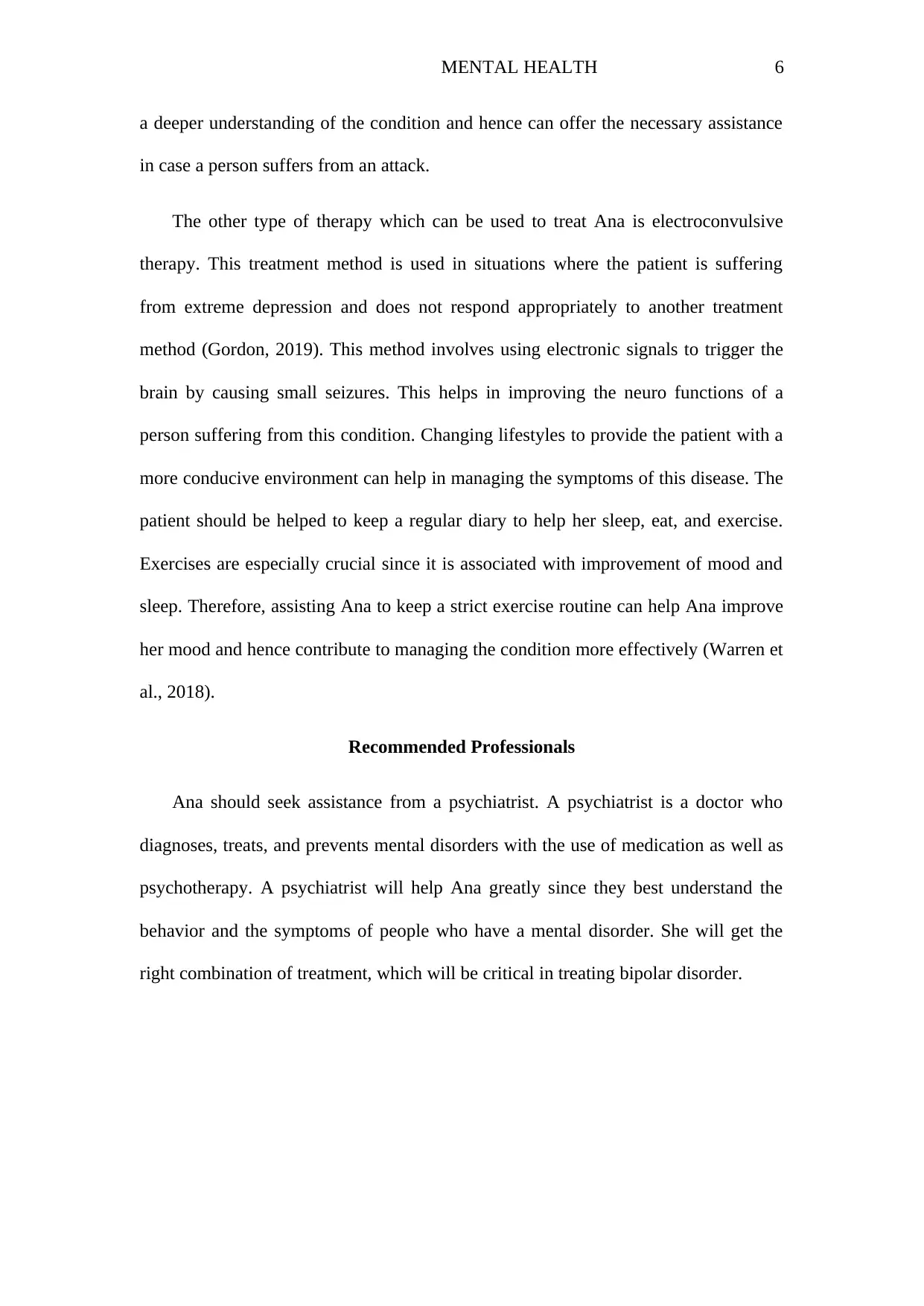
MENTAL HEALTH 6
a deeper understanding of the condition and hence can offer the necessary assistance
in case a person suffers from an attack.
The other type of therapy which can be used to treat Ana is electroconvulsive
therapy. This treatment method is used in situations where the patient is suffering
from extreme depression and does not respond appropriately to another treatment
method (Gordon, 2019). This method involves using electronic signals to trigger the
brain by causing small seizures. This helps in improving the neuro functions of a
person suffering from this condition. Changing lifestyles to provide the patient with a
more conducive environment can help in managing the symptoms of this disease. The
patient should be helped to keep a regular diary to help her sleep, eat, and exercise.
Exercises are especially crucial since it is associated with improvement of mood and
sleep. Therefore, assisting Ana to keep a strict exercise routine can help Ana improve
her mood and hence contribute to managing the condition more effectively (Warren et
al., 2018).
Recommended Professionals
Ana should seek assistance from a psychiatrist. A psychiatrist is a doctor who
diagnoses, treats, and prevents mental disorders with the use of medication as well as
psychotherapy. A psychiatrist will help Ana greatly since they best understand the
behavior and the symptoms of people who have a mental disorder. She will get the
right combination of treatment, which will be critical in treating bipolar disorder.
a deeper understanding of the condition and hence can offer the necessary assistance
in case a person suffers from an attack.
The other type of therapy which can be used to treat Ana is electroconvulsive
therapy. This treatment method is used in situations where the patient is suffering
from extreme depression and does not respond appropriately to another treatment
method (Gordon, 2019). This method involves using electronic signals to trigger the
brain by causing small seizures. This helps in improving the neuro functions of a
person suffering from this condition. Changing lifestyles to provide the patient with a
more conducive environment can help in managing the symptoms of this disease. The
patient should be helped to keep a regular diary to help her sleep, eat, and exercise.
Exercises are especially crucial since it is associated with improvement of mood and
sleep. Therefore, assisting Ana to keep a strict exercise routine can help Ana improve
her mood and hence contribute to managing the condition more effectively (Warren et
al., 2018).
Recommended Professionals
Ana should seek assistance from a psychiatrist. A psychiatrist is a doctor who
diagnoses, treats, and prevents mental disorders with the use of medication as well as
psychotherapy. A psychiatrist will help Ana greatly since they best understand the
behavior and the symptoms of people who have a mental disorder. She will get the
right combination of treatment, which will be critical in treating bipolar disorder.
⊘ This is a preview!⊘
Do you want full access?
Subscribe today to unlock all pages.

Trusted by 1+ million students worldwide
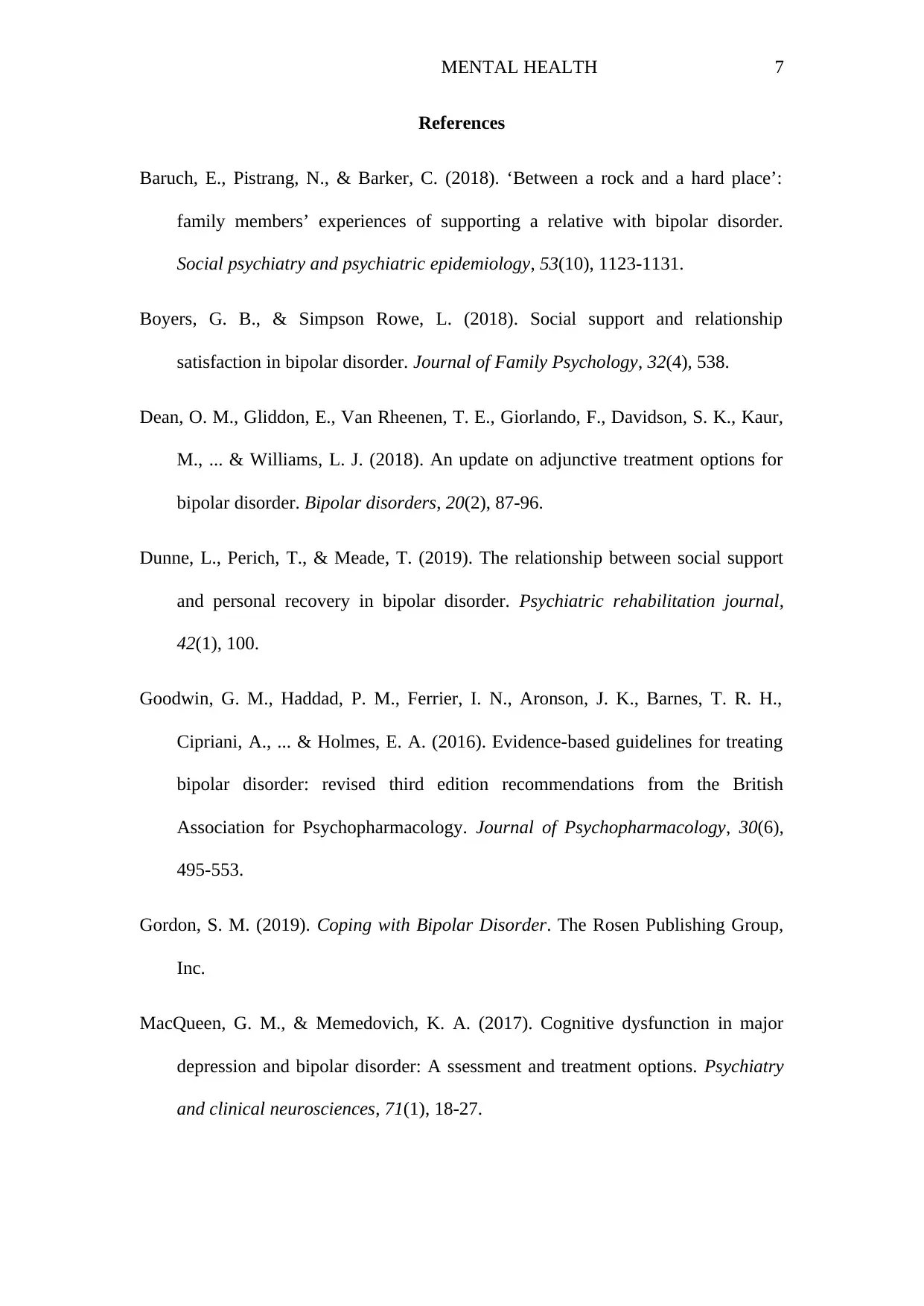
MENTAL HEALTH 7
References
Baruch, E., Pistrang, N., & Barker, C. (2018). ‘Between a rock and a hard place’:
family members’ experiences of supporting a relative with bipolar disorder.
Social psychiatry and psychiatric epidemiology, 53(10), 1123-1131.
Boyers, G. B., & Simpson Rowe, L. (2018). Social support and relationship
satisfaction in bipolar disorder. Journal of Family Psychology, 32(4), 538.
Dean, O. M., Gliddon, E., Van Rheenen, T. E., Giorlando, F., Davidson, S. K., Kaur,
M., ... & Williams, L. J. (2018). An update on adjunctive treatment options for
bipolar disorder. Bipolar disorders, 20(2), 87-96.
Dunne, L., Perich, T., & Meade, T. (2019). The relationship between social support
and personal recovery in bipolar disorder. Psychiatric rehabilitation journal,
42(1), 100.
Goodwin, G. M., Haddad, P. M., Ferrier, I. N., Aronson, J. K., Barnes, T. R. H.,
Cipriani, A., ... & Holmes, E. A. (2016). Evidence-based guidelines for treating
bipolar disorder: revised third edition recommendations from the British
Association for Psychopharmacology. Journal of Psychopharmacology, 30(6),
495-553.
Gordon, S. M. (2019). Coping with Bipolar Disorder. The Rosen Publishing Group,
Inc.
MacQueen, G. M., & Memedovich, K. A. (2017). Cognitive dysfunction in major
depression and bipolar disorder: A ssessment and treatment options. Psychiatry
and clinical neurosciences, 71(1), 18-27.
References
Baruch, E., Pistrang, N., & Barker, C. (2018). ‘Between a rock and a hard place’:
family members’ experiences of supporting a relative with bipolar disorder.
Social psychiatry and psychiatric epidemiology, 53(10), 1123-1131.
Boyers, G. B., & Simpson Rowe, L. (2018). Social support and relationship
satisfaction in bipolar disorder. Journal of Family Psychology, 32(4), 538.
Dean, O. M., Gliddon, E., Van Rheenen, T. E., Giorlando, F., Davidson, S. K., Kaur,
M., ... & Williams, L. J. (2018). An update on adjunctive treatment options for
bipolar disorder. Bipolar disorders, 20(2), 87-96.
Dunne, L., Perich, T., & Meade, T. (2019). The relationship between social support
and personal recovery in bipolar disorder. Psychiatric rehabilitation journal,
42(1), 100.
Goodwin, G. M., Haddad, P. M., Ferrier, I. N., Aronson, J. K., Barnes, T. R. H.,
Cipriani, A., ... & Holmes, E. A. (2016). Evidence-based guidelines for treating
bipolar disorder: revised third edition recommendations from the British
Association for Psychopharmacology. Journal of Psychopharmacology, 30(6),
495-553.
Gordon, S. M. (2019). Coping with Bipolar Disorder. The Rosen Publishing Group,
Inc.
MacQueen, G. M., & Memedovich, K. A. (2017). Cognitive dysfunction in major
depression and bipolar disorder: A ssessment and treatment options. Psychiatry
and clinical neurosciences, 71(1), 18-27.
Paraphrase This Document
Need a fresh take? Get an instant paraphrase of this document with our AI Paraphraser
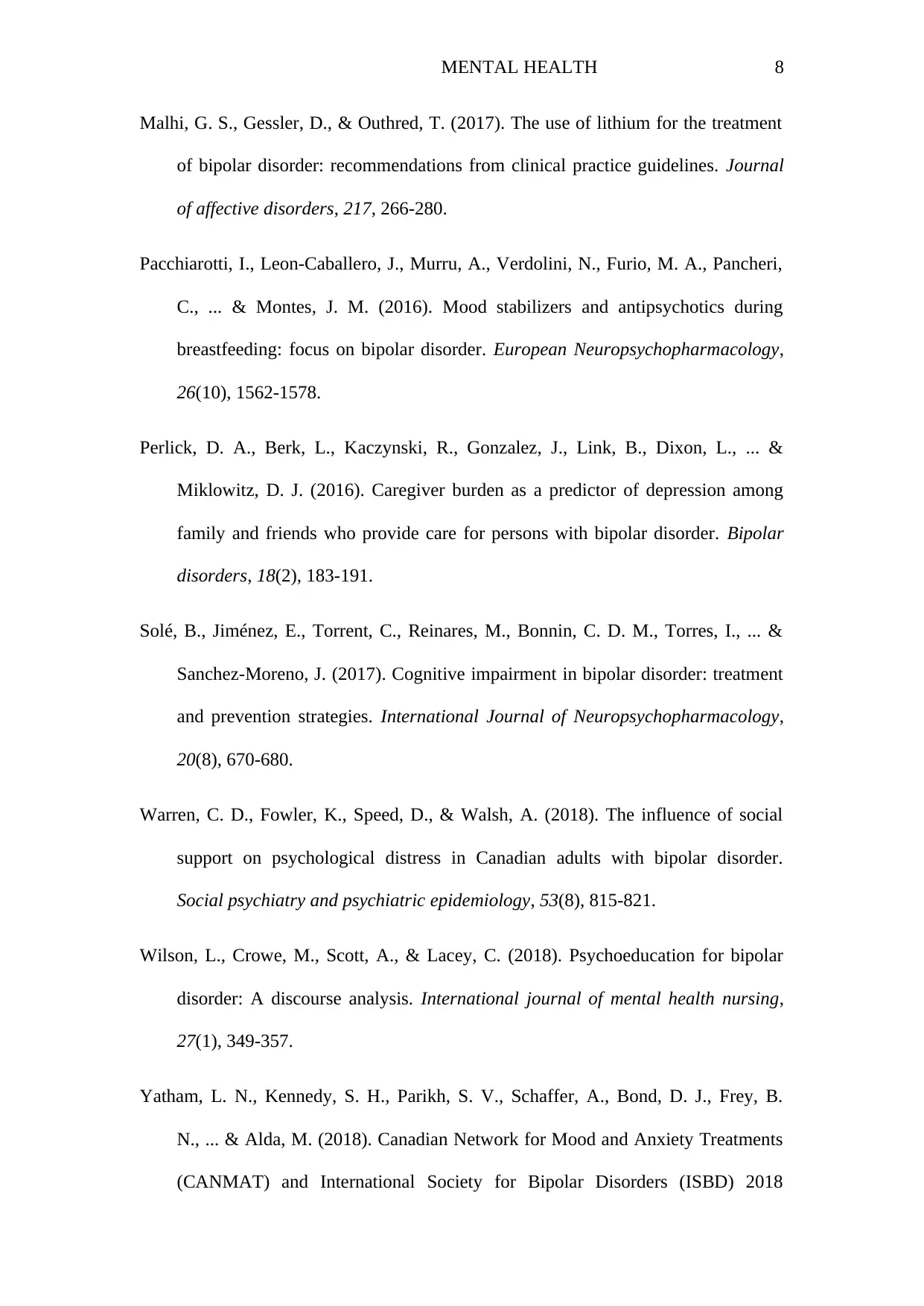
MENTAL HEALTH 8
Malhi, G. S., Gessler, D., & Outhred, T. (2017). The use of lithium for the treatment
of bipolar disorder: recommendations from clinical practice guidelines. Journal
of affective disorders, 217, 266-280.
Pacchiarotti, I., Leon-Caballero, J., Murru, A., Verdolini, N., Furio, M. A., Pancheri,
C., ... & Montes, J. M. (2016). Mood stabilizers and antipsychotics during
breastfeeding: focus on bipolar disorder. European Neuropsychopharmacology,
26(10), 1562-1578.
Perlick, D. A., Berk, L., Kaczynski, R., Gonzalez, J., Link, B., Dixon, L., ... &
Miklowitz, D. J. (2016). Caregiver burden as a predictor of depression among
family and friends who provide care for persons with bipolar disorder. Bipolar
disorders, 18(2), 183-191.
Solé, B., Jiménez, E., Torrent, C., Reinares, M., Bonnin, C. D. M., Torres, I., ... &
Sanchez-Moreno, J. (2017). Cognitive impairment in bipolar disorder: treatment
and prevention strategies. International Journal of Neuropsychopharmacology,
20(8), 670-680.
Warren, C. D., Fowler, K., Speed, D., & Walsh, A. (2018). The influence of social
support on psychological distress in Canadian adults with bipolar disorder.
Social psychiatry and psychiatric epidemiology, 53(8), 815-821.
Wilson, L., Crowe, M., Scott, A., & Lacey, C. (2018). Psychoeducation for bipolar
disorder: A discourse analysis. International journal of mental health nursing,
27(1), 349-357.
Yatham, L. N., Kennedy, S. H., Parikh, S. V., Schaffer, A., Bond, D. J., Frey, B.
N., ... & Alda, M. (2018). Canadian Network for Mood and Anxiety Treatments
(CANMAT) and International Society for Bipolar Disorders (ISBD) 2018
Malhi, G. S., Gessler, D., & Outhred, T. (2017). The use of lithium for the treatment
of bipolar disorder: recommendations from clinical practice guidelines. Journal
of affective disorders, 217, 266-280.
Pacchiarotti, I., Leon-Caballero, J., Murru, A., Verdolini, N., Furio, M. A., Pancheri,
C., ... & Montes, J. M. (2016). Mood stabilizers and antipsychotics during
breastfeeding: focus on bipolar disorder. European Neuropsychopharmacology,
26(10), 1562-1578.
Perlick, D. A., Berk, L., Kaczynski, R., Gonzalez, J., Link, B., Dixon, L., ... &
Miklowitz, D. J. (2016). Caregiver burden as a predictor of depression among
family and friends who provide care for persons with bipolar disorder. Bipolar
disorders, 18(2), 183-191.
Solé, B., Jiménez, E., Torrent, C., Reinares, M., Bonnin, C. D. M., Torres, I., ... &
Sanchez-Moreno, J. (2017). Cognitive impairment in bipolar disorder: treatment
and prevention strategies. International Journal of Neuropsychopharmacology,
20(8), 670-680.
Warren, C. D., Fowler, K., Speed, D., & Walsh, A. (2018). The influence of social
support on psychological distress in Canadian adults with bipolar disorder.
Social psychiatry and psychiatric epidemiology, 53(8), 815-821.
Wilson, L., Crowe, M., Scott, A., & Lacey, C. (2018). Psychoeducation for bipolar
disorder: A discourse analysis. International journal of mental health nursing,
27(1), 349-357.
Yatham, L. N., Kennedy, S. H., Parikh, S. V., Schaffer, A., Bond, D. J., Frey, B.
N., ... & Alda, M. (2018). Canadian Network for Mood and Anxiety Treatments
(CANMAT) and International Society for Bipolar Disorders (ISBD) 2018

MENTAL HEALTH 9
guidelines for the management of patients with bipolar disorder. Bipolar
disorders, 20(2), 97-170.
guidelines for the management of patients with bipolar disorder. Bipolar
disorders, 20(2), 97-170.
⊘ This is a preview!⊘
Do you want full access?
Subscribe today to unlock all pages.

Trusted by 1+ million students worldwide
1 out of 9
Related Documents
Your All-in-One AI-Powered Toolkit for Academic Success.
+13062052269
info@desklib.com
Available 24*7 on WhatsApp / Email
![[object Object]](/_next/static/media/star-bottom.7253800d.svg)
Unlock your academic potential
Copyright © 2020–2025 A2Z Services. All Rights Reserved. Developed and managed by ZUCOL.





